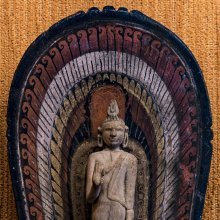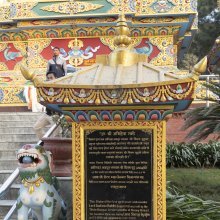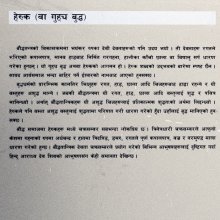Nirmita, Nirmitā: 22 definitions
Introduction:
Nirmita means something in Buddhism, Pali, Hinduism, Sanskrit, Marathi, Hindi. If you want to know the exact meaning, history, etymology or English translation of this term then check out the descriptions on this page. Add your comment or reference to a book if you want to contribute to this summary article.
Alternative spellings of this word include Nirmit.
Images (photo gallery)
In Hinduism
Purana and Itihasa (epic history)
Source: archive.org: Shiva Purana - English Translation1) Nirmita (निर्मित) refers to “creation” (e.g., the universe ‘created’ by Brahmā), according to the Śivapurāṇa 2.3.15 (“The penance and reign of Tārakāsura”).—Accordingly, as Tāraka said to Brahmā: “O Pitāmaha, if you are glad and ready to grant me the boon what is it that cannot be achieved by me? Hence I request you for this boon. Please listen. O lord of gods, if you are pleased and if a boon is to be given to me, be kind enough to grant me two boons. O great lord, there should certainly be no man equal to me in strength in this entire universe created [i.e., nirmita] by you. [...]”.
2) Nirmita (निर्मित) refers to the “construction (of a weapon)”, according to the Śivapurāṇa 2.3.17 (“The dialogue between Indra and Kāmadeva”).—Accordingly, as Indra said to Kāma: “[...] O dear, for my conquest, the unparallelled thunderbolt has been made [i.e., nirmita]. Even that weapon may sometimes be ineffective but you are never so. Who can be dearer than the person from whom one derives benefit? Hence you, my greatest friend, must carry out my task. Time being accursed, a great irremediable misery has befallen me. None other than you can dispel it”.

The Purana (पुराण, purāṇas) refers to Sanskrit literature preserving ancient India’s vast cultural history, including historical legends, religious ceremonies, various arts and sciences. The eighteen mahapuranas total over 400,000 shlokas (metrical couplets) and date to at least several centuries BCE.
Shaktism (Shakta philosophy)
Source: Google Books: ManthanabhairavatantramNirmita (निर्मित) refers to “having created” (the Paścima Krama lineage), according to the Kularatnoddyota verse 2.12-20.—Accordingly, “Initially, O great goddess, Ādinātha created (nirmita) the Paścima Krama lineage and then, O dear one, he worshipped it himself with a sacrificial substance born from his own body and possessing marvellous power. O fair one, (this is) the most excellent Krama which bestows the fruit of enjoyment and liberation”.
Source: Brill: Śaivism and the Tantric Traditions (shaktism)Nirmitā (निर्मिता) refers to “(she who has) fathomed (true knowledge)”, according to Sāhib Kaul’s Śārikāstrotra.—Accordingly, “[...] He is born in a good family, his mother is blessed, and he receives good wishes. He knows everything about [Śārikā,] the beloved of Śiva, who has fathomed (nirmitā) true knowledge through devotion. My devotion to you nourishes me every day, as the rise of the full moon always nourishes the ocean. On account of the true affluence of victorious devotion to you I even ignore the excellent Lakṣmī. [...]”.

Shakta (शाक्त, śākta) or Shaktism (śāktism) represents a tradition of Hinduism where the Goddess (Devi) is revered and worshipped. Shakta literature includes a range of scriptures, including various Agamas and Tantras, although its roots may be traced back to the Vedas.
Shaivism (Shaiva philosophy)
Source: SOAS University of London: Protective Rites in the Netra TantraNirmita (निर्मित) refers to “(being) made out of the (three Tattvas)”, according to the Netratantra of Kṣemarāja: a Śaiva text from the 9th century in which Śiva (Bhairava) teaches Pārvatī topics such as metaphysics, cosmology, and soteriology.—Accordingly, [verse 21.15-19]—“[...] Everything that is seen is made out of the three Tattvas (tri-tattva-nirmita). O Devī, without three kinds of tattvas, no meaning of a word [can be] known. From this are all three kinds of tattvas, [from] highest to lowest. Mantras possess the nature of Śiva, are to be known as the form of Śakti, [and] in that manner [are] aṇu. Unbounded energies proceed [through] the distribution of the three kinds of tattvas”.

Shaiva (शैव, śaiva) or Shaivism (śaivism) represents a tradition of Hinduism worshiping Shiva as the supreme being. Closely related to Shaktism, Shaiva literature includes a range of scriptures, including Tantras, while the root of this tradition may be traced back to the ancient Vedas.
Sports, Arts and Entertainment (wordly enjoyments)
Source: archive.org: Syainika Sastra of Rudradeva with English Translation (art)1) Nirmita (निर्मित) refers to “having written” (on a particular science) (e.g., the science of love), according to the Śyainika-śāstra: a Sanskrit treatise dealing with the divisions and benefits of Hunting and Hawking, written by Rājā Rudradeva (or Candradeva) in possibly the 13th century.—Accordingly, “Is not love experienced by those who are ignorant of, the science of Erotics? Still the sages have written (nirmita) on the science for its thorough realization. In the same manner, though the delights of hunting are well known even to men of no intelligence, still hunting affords peculiar delight to the mind of one who knows the science of hawking. [...]”.
2) Nirmitā (निर्मिता) refers to “having created” (a medicinal pill, used in the treatment of Hawks), according to the Śyainika-śāstra.—Accordingly, [while discussing the treatment of hawks]: “If a white spot forms on the eyes owing to heat, smoke or some kind of hurt, [...] Or a pill made of the following drugs in equal quantities, soaked in goat’s urine and dried in the shade, may be given; turmeric, leaves of nīm/neem, pepper, yellow myrobalan, long pepper, Cyperus rotundus, and viḍaṅga. It should be administered with honey and goat’s milk in the case of the red kind of birds. This pill destroys the spot, as if the pill had been made (nirmitā) by Rudra”.

This section covers the skills and profiencies of the Kalas (“performing arts”) and Shastras (“sciences”) involving ancient Indian traditions of sports, games, arts, entertainment, love-making and other means of wordly enjoyments. Traditionally these topics were dealt with in Sanskrit treatises explaing the philosophy and the justification of enjoying the pleasures of the senses.
In Buddhism
Mahayana (major branch of Buddhism)
Source: Wisdom Library: Maha Prajnaparamita SastraNirmita (निर्मित) refers to “apparitional creations” according to the 2nd century Mahāprajñāpāramitāśāstra (chapter XIV), “There cannot be two minds (citta) at the same time: when the apparitional (nirmita) Buddhas speak, the master who creates them (nirmātṛ) must be silent; when the creating master speaks, the apparitional creations must be silent”.
Note: Undoubtedly the Mahāprajñāpāramitāśāstra is referring here to the theory of nirmita explained in the Kāraṇaprajñapti, which is one of the seven books of the Abhidharma.
Source: academia.edu: A Study and Translation of the GaganagañjaparipṛcchāNirmita (निर्मित) refers to a “magical apparition”, according to the Gaganagañjaparipṛcchā: the eighth chapter of the Mahāsaṃnipāta (a collection of Mahāyāna Buddhist Sūtras).—Accordingly, “When this had been said, the Lord said to the Bodhisattva, the great being Gaganagañja: ‘[...] Just as a magical apparition (nirmita) gives a gift to [another] magical apparition without conceptualization and effort, in the same way, the Bodhisatva gives a pure gift as having the essence characterized by illusion, because it is free from the duality of thoughts, mind and consciousness and the hope for any recompense concerning any dharma. [...]’”.

Mahayana (महायान, mahāyāna) is a major branch of Buddhism focusing on the path of a Bodhisattva (spiritual aspirants/ enlightened beings). Extant literature is vast and primarely composed in the Sanskrit language. There are many sūtras of which some of the earliest are the various Prajñāpāramitā sūtras.
Tibetan Buddhism (Vajrayana or tantric Buddhism)
Source: Wisdom Library: Tibetan BuddhismNirmitā (निर्मिता) is the name of Dūtī (i.e., messengers of Lord Vajrapāṇi) mentioned as attending the teachings in the 6th century Mañjuśrīmūlakalpa: one of the largest Kriyā Tantras devoted to Mañjuśrī (the Bodhisattva of wisdom) representing an encyclopedia of knowledge primarily concerned with ritualistic elements in Buddhism. The teachings in this text originate from Mañjuśrī and were taught to and by Buddha Śākyamuni in the presence of a large audience (including Nirmitā).
Source: OSU Press: Cakrasamvara SamadhiNirmita (निर्मित) refers to “fixed” (resting on Meru), according to the Guru Mandala Worship (maṇḍalārcana) ritual often performed in combination with the Cakrasaṃvara Samādhi, which refers to the primary pūjā and sādhanā practice of Newah Mahāyāna-Vajrayāna Buddhists in Nepal.—Accordingly, “In praise (of) Śrī Vajrasattva, highest universal guru, origin of all Buddhas, By various forms, removing darkness and fear, fixed resting on Meru (nirmita—nirmitaṃ meru-saṃstham). Dharma sustainer, chief sage, most fortunate victor, Vajradhātu mandala, In one form with all bliss, innate bliss, embodied, the cause for liberation”.

Tibetan Buddhism includes schools such as Nyingma, Kadampa, Kagyu and Gelug. Their primary canon of literature is divided in two broad categories: The Kangyur, which consists of Buddha’s words, and the Tengyur, which includes commentaries from various sources. Esotericism and tantra techniques (vajrayāna) are collected indepently.
Languages of India and abroad
Marathi-English dictionary
Source: DDSA: The Molesworth Marathi and English Dictionarynirmita (निर्मित).—p (S) Created: also made, formed, or produced gen. 2 Predestined or predetermined.
Source: DDSA: The Aryabhusan school dictionary, Marathi-Englishnirmita (निर्मित).—p Created; made, produced.
Marathi is an Indo-European language having over 70 million native speakers people in (predominantly) Maharashtra India. Marathi, like many other Indo-Aryan languages, evolved from early forms of Prakrit, which itself is a subset of Sanskrit, one of the most ancient languages of the world.
Sanskrit dictionary
Source: DDSA: The practical Sanskrit-English dictionaryNirmita (निर्मित).—p. p.
1) Constructed, built, formed, prepared, made &c.
2) (in law) Fixed, settled; एवं धर्मं विजानीमः प्राक् प्रजापतिनिर्मितम् (evaṃ dharmaṃ vijānīmaḥ prāk prajāpatinirmitam) Manusmṛti 9.46.
3) Artificial.
4) Performed, celebrated (a ceremony); ज्योतिष्टोमायुषी चैवमति- रात्रौ च निर्मितौ (jyotiṣṭomāyuṣī caivamati- rātrau ca nirmitau) Rām.1.14.42.
Source: Cologne Digital Sanskrit Dictionaries: Edgerton Buddhist Hybrid Sanskrit DictionaryNirmita (निर्मित).—(= Pali nimmita), (1) ppp. of nirminoti, q.v.; (2) nt., a magic creation: bhagavān °taṃ visarjayati Divyāvadāna 138.13; Avadāna-śataka i.4.12; nirmitopamaṃ māyopamaṃ Saddharmapuṇḍarīka 137.10, like a magic creation, an illusory thing (mirage); (3) as name of a class of gods, = nirmāṇarati; so very clearly in Mahāvastu ii.349.13 (verse) °tā (devāḥ), the verse equivalent of nirmāṇaratī 348.17 (prose); elsewhere, Saddharmapuṇḍarīka 235.1—2 (prose, see s.v. samāvartayati); 237.2, 6; Lalitavistara 45.11; 50.5 (read nirmitāś for nim°); 213.15; 215.13; 219.8; sg., one of the class, 241.2; (4) name of a former Buddha: Mahāvastu iii.237.11; (5) name of a Bodhisattva: Gaṇḍavyūha 442.3.
Source: Cologne Digital Sanskrit Dictionaries: Shabda-Sagara Sanskrit-English DictionaryNirmita (निर्मित) or Nirmmita.—mfn.
(-taḥ-tā-taṃ) 1. Made. 2. Fabricated, artificial. E. nir before, mā to mete, affix kta.
Source: Cologne Digital Sanskrit Dictionaries: Cappeller Sanskrit-English DictionaryNirmita (निर्मित).—[adjective] produced, made, built, formed, created by ([instrumental] or —°), out of ([ablative], [instrumental] or —°); effected, caused, settled, determined.
Source: Cologne Digital Sanskrit Dictionaries: Monier-Williams Sanskrit-English Dictionary1) Nirmita (निर्मित):—[=nir-mita] [from nir-mā] a mfn. (nir-) constructed, built, fashioned, formed, created, made by ([instrumental case] or [compound]) out of ([ablative] [instrumental case] or [compound]), [Śatapatha-brāhmaṇa; Manu-smṛti; Mahābhārata] etc.
2) [v.s. ...] (law) fixed, settled, [Manu-smṛti ix, 46]
3) [v.s. ...] (ceremony) performed, celebrated, [Rāmāyaṇa B i, 14, 42]
4) [v.s. ...] (sacrificial animal) put apart, separated, isolated (= nir-ūḍha), [Āśvalāyana-śrauta-sūtra]
5) [v.s. ...] m. [plural] (with Buddhists) a class of deities, [Lalita-vistara]
6) [=nir-mita] [from nir-mi] b See 1. nir-mā.
Source: Cologne Digital Sanskrit Dictionaries: Yates Sanskrit-English DictionaryNirmita (निर्मित):—[nir-mita] (taḥ-tā-taṃ) a. Made, fabricated, manufactured.
Source: DDSA: Paia-sadda-mahannavo; a comprehensive Prakrit Hindi dictionary (S)Nirmita (निर्मित) in the Sanskrit language is related to the Prakrit words: Ṇimmaia, Ṇimmavia, Ṇimmāṇia, Ṇimmia.
[Sanskrit to German]
Sanskrit, also spelled संस्कृतम् (saṃskṛtam), is an ancient language of India commonly seen as the grandmother of the Indo-European language family (even English!). Closely allied with Prakrit and Pali, Sanskrit is more exhaustive in both grammar and terms and has the most extensive collection of literature in the world, greatly surpassing its sister-languages Greek and Latin.
Hindi dictionary
Source: DDSA: A practical Hindi-English dictionaryNirmita (निर्मित) [Also spelled nirmit]:—(a) constructed, built; produced; created; ~[ti] structure, construction; creation.
...
Kannada-English dictionary
Source: Alar: Kannada-English corpusNirmita (ನಿರ್ಮಿತ):—
1) [adjective] measured.
2) [adjective] constructed; made; built; produced.
--- OR ---
Nirmita (ನಿರ್ಮಿತ):—
1) [noun] the product of construction.
2) [noun] that which is created; creation.
Kannada is a Dravidian language (as opposed to the Indo-European language family) mainly spoken in the southwestern region of India.
See also (Relevant definitions)
Starts with: Nirmitaka, Nirmitam, Nirmitanirmana, Nirmitapurusha, Nirmitaraga, Nirmitavada.
Ends with: Abhinirmita, Amtarnirmita, Anilambhasunirmita, Atmanirmita, Daivanirmita, Devanirmita, Lipikarmanirmita, Mayanirmita, Mayavinirmita, Muninirmita, Paranirmita, Parinirmita, Punarnirmita, Samnirmita, Snayunirmita, Sunirmita, Suvinirmita, Tathagatanirmita, Tattvanirmita, Vinirmita.
Full-text (+60): Devanirmita, Nimmavia, Nimmania, Nirmitam, Sunirmita, Samnirmita, Nirmitaraga, Paranirmitavashavartin, Parinirmita, Parimohana, Snayunirmita, Nirumitam, Svatulya, Nimmaia, Daivanirmita, Nimmia, Abhinirmita, Muninirmita, Vinirmitsu, Vinirmiti.
Relevant text
Search found 30 books and stories containing Nirmita, Nir-mita, Nirmitā; (plurals include: Nirmitas, mitas, Nirmitās). You can also click to the full overview containing English textual excerpts. Below are direct links for the most relevant articles:
Maha Prajnaparamita Sastra (by Gelongma Karma Migme Chödrön)
Appendix 6 - The theory of nirmita < [Chapter XIV - Emission of rays]
Appendix 3 - Descent of Buddha from the Trāyastriṃśa heaven < [Chapter XVI - The Story of Śāriputra]
Part 5 - Casting the mount sumerus far away < [Chapter XLIX - The Four Conditions]
Garga Samhita (English) (by Danavir Goswami)
Verse 5.21.23 < [Chapter 21 - The Story of Śrī Nārada]
Verse 6.7.3 < [Chapter 7 - The Marriage of Śrī Rukmiṇī]
Verse 5.20.39 < [Chapter 20 - The Liberation of Ṛbhu Muni During the Rāsa-dance Festival]
The Tattvasangraha [with commentary] (by Ganganatha Jha)
Verse 111 < [Chapter 4 - The doctrine of the ‘Thing by Itself’]
Women in the Atharva-veda Samhita (by Pranab Jyoti Kalita)
6. Goddess Āsurī < [Chapter 4 - Female Deities and the Glorification of Women in the Atharvaveda]
Bhakti-rasamrta-sindhu (by Śrīla Rūpa Gosvāmī)
Verse 2.4.136 < [Part 4 - Transient Ecstatic Disturbances (vyābhicāri-bhāva)]
Verse 4.6.4 < [Part 5 - Dread (bhayānaka-rasa)]
Rig Veda (translation and commentary) (by H. H. Wilson)
Related products




